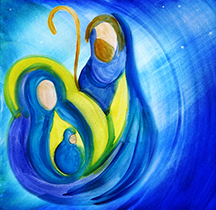By Katie Yoder
(OSV News) – For Kendra Tierney, a Catholic author and mother of 10, the Advent season leading up to Christmas is like preparing to give birth.
“There’s such a unique character to that time where you can’t rush it and that you’re trying to prepare everything,” said the founder and CEO of Catholic All Year. “I think that Advent gives us all that opportunity to really dive into that sort of feeling, where we want to use that time to prepare our homes and to prepare our families to welcome Christ into our lives.”
Advent marks the beginning of the church’s liturgical year, starting four Sundays before Christmas. The name “Advent” hints at its meaning: It comes from the Latin word “advenire,” which translates to “to come to” or “to arrive.” The season begins Dec. 3 this year.

While Advent is sometimes called “a little Lent,” Catholic experts observe that there are important similarities and differences between the two, both of which lead up to major feast days and liturgical seasons: Christmas and Easter, respectively. Advent, they agree, is primarily a season of preparation.
“Lent has that penitential character where … we are trying to focus on exercising those muscles of being penitent. I think that the character of Advent is intended to be a little different than that – that it is really, actually, a waiting for a birth,” said Tierney, who writes about living the liturgical year in the home.
In a 2019 blog post, she describes the difference from Lent: “Advent is predominantly preparation, and Lent is predominantly penance.”
The Catechism of the Catholic Church uses similar wording in describing Advent. “When the church celebrates the liturgy of Advent each year, she makes present this ancient expectancy of the Messiah, for by sharing in the long preparation for the Savior’s first coming, the faithful renew their ardent desire for his second coming,” it says.
In contrast, the catechism calls Lent one of the “intense moments of the church’s penitential practice.”
Father Agustino Torres, a Franciscan Friar of the Renewal and author of the new book “Prepare Your Hearts: A Guided Advent Journal for Prayer and Meditation,” tied the penitential and preparation aspects together.
“Although it’s not widely thought of as such, Advent is a time when we can offer up penance to prepare the way for the coming Christ Child,” he said. “It is not penitential in the same way Lent is, but there has been a long-held tradition in the church to offer up prayer vigils, fasts and offerings during Advent.”
Timothy O’Malley, the director of education at the McGrath Institute for Church Life at the University of Notre Dame in Indiana and the academic director of the Notre Dame Center for Liturgy, emphasized that much of the church’s year has historically been penitential.
“Advent takes on a penitential spirit inspired by the three-fold advent of Jesus Christ,” he said. “The Christ who comes at the end of time, who will judge the world. The Christ who comes into the heart of every believer longing for his presence. The Christ who comes as the newborn babe.”
He added: “It is penitential insofar as we have to ask ourselves if we’re ready for these various presences.”
Like Lent, Advent in the Roman Catholic Church historically included fasting, O’Malley said.
“Advent develops as a fasting period preceding the celebration of Christmas, likely connected to initiation of Christians,” he noted. “But the Roman rite was later to adopt this period of around four weeks – it’s Gregory the Great that tells us of the four weeks. We know in Milan, it was six weeks (and still is).”
Advent is also marked by the use of the Advent wreath, which O’Malley said was adopted as a practice of popular piety from Germany, and the O Antiphons, descriptions of the Messiah drawn from the Book of Isaiah which are used in the Liturgy of the Hours’ evening prayer Dec. 17-23.
Father Torres points to fasts, vigils, wreaths and readings of the Prophet Isaiah. And in many countries, he said, the period between Dec. 17 and Christmas Eve “is filled with prayers, processions and devotions followed by a celebration and songs.”
Father Torres also noted that Lent was added to the church’s liturgical calendar before Advent.
“Initially, only Easter had a preparatory season, but later Christmas developed its own similar period called Advent,” he said. “Both Advent and Lent share common features, such as violet liturgical color, omitting the Gloria at Sunday Masses, and having a Sunday of ‘joy’ during both seasons – Gaudete Sunday and Laetare Sunday.”
The seasons also have notable contrasts, Father Torres added. “While Lent lacks flowers, Advent features them moderately. Lent has images of going into the desert, Advent has a voice coming from the desert. Lent has readings of conversion of life; Advent has readings of fulfillment of prophecy in our lives. Advent has a joyous anticipation feel, because it is meant to embody the expectation for the Messiah with delightful devotion, whereas Lent has penitential practices like the Way of the Cross,” he said.
He noted that the current expectations of Advent are that it is a time of joyful anticipation.
“If your home is getting ready to receive a lovely guest, there is a time of cleaning, cooking and prepping,” he said. “We are readying our hearts for Jesus in Advent in similar ways.”
Katie Yoder writes for OSV News from the Washington, D.C., area.
